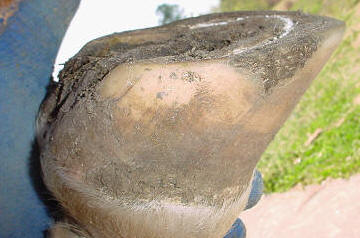 Hoofrehab.com - Full Article
Hoofrehab.com - Full Article8-16-05
Pete Ramey
The sole of the foot is the most abused and misunderstood part of the domestic horse (with the possible exception of its digestive system). I’ve been guilty of it, too. As a horseshoer it always seemed necessary for me to routinely cut the sole at the toe, and in my early days as a barefoot trimmer I thought it was desirable to thin it at the back of the foot. When I began both professions, I was taught to view the sole as an idle passenger; trimming the hoof wall to certain parameters and then trimming or relieving the sole to match. Now I see the sole as the ultimate guide for hoof trimming; keeping the bars and walls 1/16 inch above the natural callused sole plane. (See the "Heel Height" article for exceptions.) When I think back on the past and compare it to my results now, I shudder at the comparison. My own learning curve has been a long one. I hope to shorten it for you, here.
It is a confusing subject, though. It can be difficult to distinguish between healthy sole that should be preserved, false sole that should be removed, shedding sole that needs to stay around as long as possible because the new sole underneath is immature, shedding sole that needs to be removed because fungal infection underneath is eating away at the new sole that is trying to grow, unsupported sole under flared walls that needs to have pressure relief………….. The list goes on, and it seems the more you learn, the less you may understand what needs to be done. Since the sole is the first line of defense between the horse and the ground, its proper management is crucial to soundness. Luckily we have a very reliable guide. The seams between the sole and frog; the collateral grooves, are the most reliable and important guide we have for determining the needs of the foot. A full understanding of their significance and the information they offer will give you “x-ray vision” when you look at every hoof...
Read more here:
http://www.hoofrehab.com/HorsesSole.html

No comments:
Post a Comment